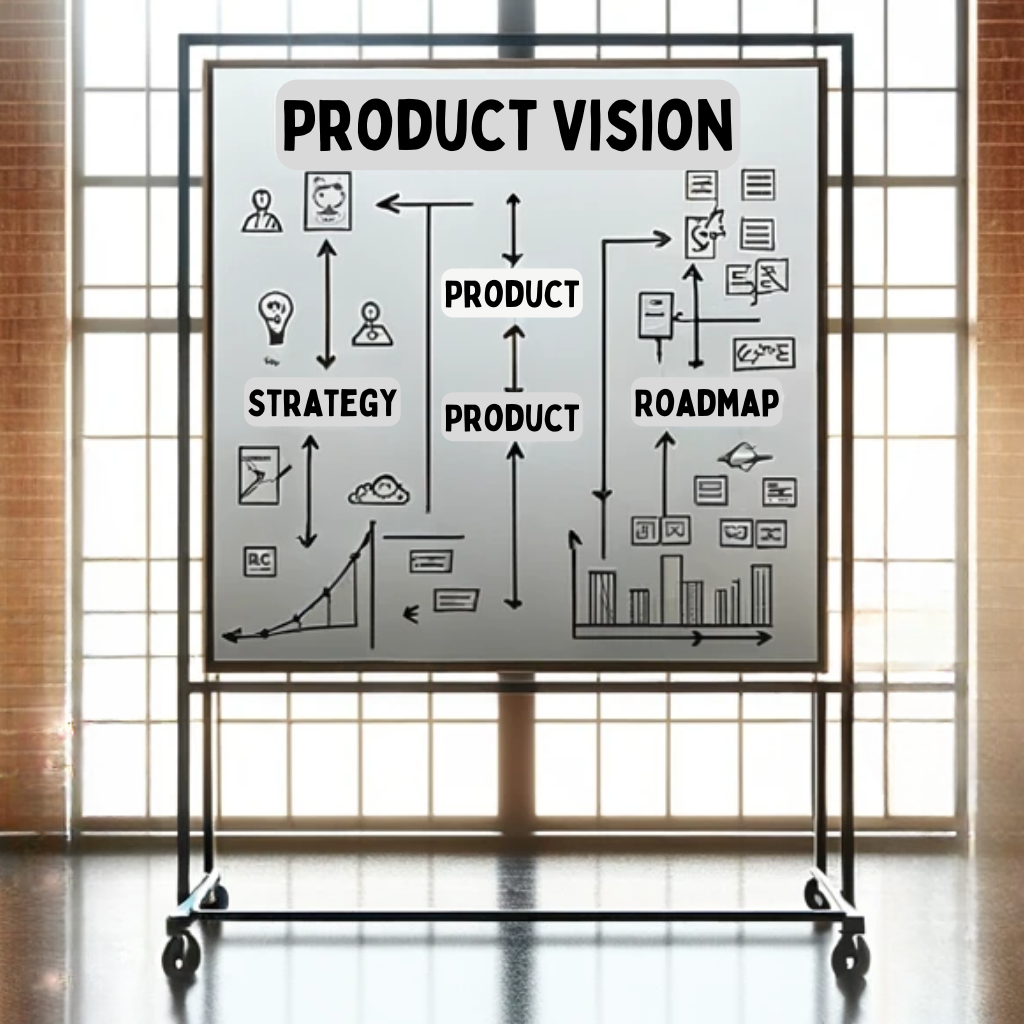Introduction
In the bustling streets of Silicon Valley, where startups sprout like wildflowers, to the innovative hubs of Copenhagen, where design meets functionality, Product Managers stand at the epicenter of technological revolution. Often working behind the scenes, they are the unsung heroes, orchestrating the symphony of product development. They juggle stakeholder expectations, user needs, market trends, and technical constraints, all while keeping an eye on the ever-evolving competitive landscape.
But what’s the secret sauce that enables these people to create products that resonate, captivate, and, most importantly, deliver value? At the heart of their toolkit lies a robust product strategy. It’s their compass in the chaotic storm of product development, ensuring that every decision, every feature, and every sprint aligns with a larger vision.
In today’s digital age, where the average user’s attention span is shorter than that of a goldfish and where competition is just a click away, having a product strategy is not just beneficial—it’s essential. It’s the difference between products that get lost in the vast sea of apps and those that rise to the top, becoming household names.
By the end of this guide, you won’t just be another professional skimming the surface. You’ll delve deep into the intricacies of crafting a winning product strategy.
So, whether you’re a seasoned Product Manager looking to refine your strategic approach or a newbie eager to make your mark, buckle up. We’re about to embark on a journey through the world of product strategy, and I promise it’s going to be enlightening!
What is Product Strategy?
Product strategy defines the “how to” and the direction to achieve the vision. It involves deliberate choices about where to compete and how to win in the market.
A well-crafted product strategy is more than a mere plan; it’s a comprehensive set of choices that sets the course for a product’s journey from conception to market dominance. At its core, product strategy intertwines a product’s vision with the business’s overarching objectives, bridging the gap between what a product could be and the strategic steps needed to realize that potential.
As markets evolve and consumer preferences shift, the role of product strategy has become increasingly crucial. It’s no longer just about outperforming competitors or launching feature-rich products. In today’s digital age, a robust product strategy is about understanding and anticipating customer needs, leveraging technological advancements, and aligning these elements with business goals. This approach ensures that products not only resonate with target audiences but also contribute significantly to the company’s growth and sustainability.
This article will delve into the nuances of developing and implementing a successful product strategy. From understanding its key components to navigating the challenges of execution, we aim to provide a comprehensive guide that will equip product managers and strategists with the insights and tools needed for crafting winning product strategies in the modern business landscape.
Defining Product Strategy
At its core, a product strategy is a cohesive direction that aligns product goals with overarching business objectives. Think of it as the DNA of your product. It’s the genetic code that determines how your product grows, evolves, and interacts with its environment. It’s not just about deciding what features to add, which color scheme to choose, or which market to target.
It’s the foundational roadmap that answers the pivotal question: “Why are we building this?“
Product Strategy vs. Product Vision
Imagine you’re an explorer. Your product vision is the fabled treasure you’re seeking, the grand dream of what you hope to achieve. It’s the beacon on the horizon, guiding your journey. The product strategy, on the other hand, is your treasure map. It’s the actionable steps, the challenges you’ll face, and the resources you’ll need to reach that treasure. While the vision paints the big picture, the strategy breaks it down into tangible, achievable segments.
Product Strategy vs. Product Roadmap
Continuing with our explorer analogy, if the strategy is your treasure map, then the product roadmap is your itinerary. It’s the detailed plan of “how” you’ll navigate the terrain and “when” you’ll reach specific milestones. The roadmap takes the broader strokes of the strategy and translates them into timelines, tasks, and checkpoints. It’s the tactical layer, ensuring that every team member knows their role, deadlines, and the sequence of tasks leading to product success.
In Essence…
A product without a strategy is like a ship without a compass. You might have a general direction, but you’ll be swayed by every wind and wave, leading to a product that’s disjointed and lacks focus. As Product Managers, our role is to ensure that every decision, big or small, aligns with our product strategy, ensuring a cohesive user experience and a product that not only meets but exceeds business objectives.
Why Product Strategy is Crucial for Product Managers
In the digital age, where the pace of innovation is relentless and the competition fierce, the role of a Product Manager has never been more challenging—or more critical. At the heart of this role lies the product strategy, a compass that guides every decision, every pivot, every launch. But why is it so indispensable?
- Building with Purpose: Imagine embarking on the monumental task of building a house. You’ve envisioned a modern architectural marvel, complete with panoramic windows and a rooftop garden. But instead of consulting an architect for a blueprint, you dive in headfirst, brick by brick. Sounds chaotic, right? That’s precisely what product development feels like without a clear strategy. It’s like navigating a dense forest without a map, hoping to stumble upon a clearing.
- Guided Development: A product strategy acts as this map. It ensures that every feature added, every line of code written, and every design decision made aligns with the end goal. It’s not about adding features for the sake of it or chasing every new tech trend. It’s about purposeful, guided development, where every step taken is a step closer to the envisioned product.
- Business Alignment: In the corporate world, where departments often operate in silos, a product strategy bridges the gap. It ensures that the product’s direction is in harmony with the company’s broader objectives. Whether it’s increasing market share, venturing into new demographics, or enhancing brand loyalty, a well-defined product strategy ensures that the product team and the company’s leadership are on the same page.
- User-Centricity: In today’s user-driven market, products that don’t resonate with their audience are destined for obscurity. A product strategy ensures that the product is not just built for users but built around them. It’s a commitment to understanding user pain points, desires, and behaviors, ensuring that the product not only meets but anticipates their needs.
- The Bottom Line: Without a product strategy, Product Managers are like sailors adrift at sea, at the mercy of the winds and currents. With it, they become captains, steering their ship with confidence and precision. In the dynamic world of product development, where change is the only constant, a robust product strategy is the anchor that ensures stability, direction, and success.

Key Elements of Effective Product Strategy
An effective product strategy is built on several key elements that collectively define the path to success for a product:
- Vision and Mission: The foundation of a product strategy, the vision and mission articulate the long-term aspirations and purpose of the product. This sets the stage for what the product aims to achieve in the broader market context.
- Target Market and Customer Needs: Understanding the target market and the specific needs of customers is crucial. This involves segmenting the market, identifying customer pain points, and tailoring the product to meet these needs.
- Competitive Analysis and Differentiation: Analyzing competitors and identifying a product’s unique selling points are essential for differentiation. This includes understanding competitors’ strengths and weaknesses and positioning the product to capitalize on market opportunities.
Together, these elements form a strategic framework that guides every aspect of product development, from design and features to marketing and sales. They ensure that the product strategy is not only aligned with the company’s goals but also resonates with customers and stands out in the competitive landscape.
Product Strategy Frameworks: Structuring for Success
Product strategy frameworks are structured approaches that guide businesses in developing, managing, and evolving their products. These frameworks provide a systematic way to address various components of product strategy, ensuring a comprehensive and effective plan.
Popular Product Strategy Frameworks
- SWOT Analysis: Evaluates internal Strengths and Weaknesses, and external Opportunities and Threats. It’s useful for understanding the current strategic position of a product.
- BCG Matrix: Categorizes products based on market growth rate and market share. It helps in strategic resource allocation, focusing on products that can generate the most revenue.
- Porter’s Five Forces: Analyzes competitive forces within an industry – competitive rivalry, threat of new entrants, threat of substitutes, bargaining power of buyers, and bargaining power of suppliers. It’s instrumental in strategic planning to overcome these forces.
- Ansoff Matrix: Focuses on growth strategies through market penetration, market development, product development, and diversification, helping in decision-making about expanding or modifying the product portfolio.
- Jobs-to-be-Done Framework: Centers on understanding customer needs and the “jobs” customers are trying to accomplish. This framework aids in developing products that are truly useful for the target market.
Choosing the right Product Strategy framework
Each framework offers unique insights and is best chosen based on the specific context and objectives of the product strategy. The best product strategy framework for developing and presenting a strategy to stakeholders often depends on the specific context and needs of the business.
- Align with Business Goals: Choose a framework that aligns with your overall business objectives.
- Understand Customer Needs: Frameworks should be used in conjunction with deep customer understanding.
- Stay Agile and Flexible: Be prepared to adapt your strategy based on framework insights and market changes.
The Jobs-to-be-Done Framework is highly effective for its focus on customer needs and outcomes. It centers on understanding the “jobs” customers hire a product to do, aligning the product’s development with these requirements. This customer-centric approach is particularly useful in communicating the strategy’s relevance and value to stakeholders, ensuring that the product aligns with market demands and customer expectations.
How to make a Product Strategy – 5 steps
The development of a product strategy is a multifaceted process that requires a blend of strategic thinking, market analysis, and careful planning.
It is a journey that begins with a clear vision and translates into actionable steps to bring a product to life. This process encompasses understanding the market landscape, identifying customer needs, setting achievable goals, and mapping out the path to reach them. By aligning the product’s unique features and capabilities with the needs of the target market, a product strategy lays the groundwork for a product’s success. This section will explore the essential steps involved in developing a robust product strategy, offering a roadmap for product managers and strategists to navigate the complexities of bringing a product from concept to reality.
Check out our podcast “Product Disorder” to learn more about product strategy from the experts.
How to make a Product Strategy
Discovery and Co-Creation
Conduct internal and external sessions to gather diverse perspectives. Involve team members, stakeholders, and customers in the strategy development process. Undertake thorough market research to understand customer needs, market trends, and competitive landscapes. This helps in identifying opportunities and threats. Read more about Customer Discovery.
Define a Clear Vision
Start by defining a compelling vision for the product. This vision should align with the company’s broader goals and set the direction for the product’s future. 5 Tips to build a strong product vision
Document the decisions (or bets) on how to achieve the Vision
Based on the vision and market insights, backtrace how you want to achieve the Vision. Set specific, measurable goals for the product.
Determining Key Features and Capabilities
Decide on the core features and capabilities that will make the product unique and valuable to customers.
Iterative Review and Adaptation
Continuously review and adapt the strategy based on feedback and changing market conditions.
This approach ensures that the product strategy is well-defined, market-informed, and capable of guiding the product to success.
Common Pitfalls in Product Strategy (and How to Avoid Them)
In the intricate dance of product management, even seasoned professionals can occasionally misstep. While crafting a product strategy is an art and science combined, there are common pitfalls that many fall into. Let’s explore these traps and, more importantly, how to sidestep them.
1. Overloading Features Without Clear Value
The Pitfall: In the race to outdo competitors, there’s a temptation to pack a product with features, believing that more is always better. However, this can lead to a cluttered user experience and a product that’s jack of all trades, master of none.
How to Avoid:
- Lean on User Research: Before adding a feature, conduct user research to determine if it’s genuinely needed. Tools like user surveys, feedback sessions, and A/B testing can be invaluable.
- Prioritize Features: Use a framework like the MoSCoW method (Must have, Should have, Could have, Won’t have) to prioritize features based on their impact and feasibility.
2. Neglecting Market Shifts and User Feedback
The Pitfall: The tech landscape is ever-evolving. Failing to adapt to market shifts or ignoring user feedback can render a product obsolete.
How to Avoid:
- Stay Updated: Subscribe to industry news, attend webinars, and participate in relevant forums. Tools like Google Alerts can notify you of industry-specific updates.
- Feedback Channels: Ensure there are clear channels for users to provide feedback. Regularly review this feedback and consider it during product iterations.
3. Lack of Alignment with Broader Business Goals
The Pitfall: Sometimes, in the quest to perfect a product, Product Managers might lose sight of the broader business objectives, leading to a misaligned product strategy.
How to Avoid:
- Regular Sync-ups: Hold regular meetings with stakeholders, including marketing, sales, and leadership teams, to ensure alignment.
- Document Business Goals: Clearly document the company’s business goals and ensure they’re accessible to the product team. Every strategic decision should be cross-referenced with these goals to ensure alignment.
So, how does the finalized product strategy look like?
So should the Product Strategy look like? What is the final artefact? To effectively present, communicate, and elicit feedback on a finalized product strategy, consider the following approach:
- Clear and Concise Presentation: Use visual aids like slides or infographics that succinctly outline the strategy. Avoid jargon and keep the language simple and direct.
- Tailoring to the Audience: Adjust the level of detail based on the audience’s familiarity with the product and their role.
- Interactive Presentation: Tools like PowerPoint or interactive dashboards can be used for a dynamic presentation.
- Feedback Mechanisms: Incorporate Q&A sessions, surveys, or workshops to gather feedback.
- Documentation: Provide a comprehensive document outlining the strategy for stakeholders to review in detail.
Remember to tailor the Presentation to the Audience: Highlight aspects most relevant to the stakeholders
Product Strategy Templates and Suggested Format
Product strategy templates provide a structured approach to documenting and communicating your strategy. A recommended format includes:
- Executive Summary: A brief overview of the product strategy, highlighting key objectives and goals.
- Market Analysis: Insights into the target market, customer needs, and competitive landscape.
- Product Vision and Goals: Clear articulation of the product vision and specific, measurable goals.
- Strategic Initiatives: Detailed description of strategic initiatives and how they align with the product vision and market needs.
- Roadmap Overview: A high-level view of the product roadmap, showing key milestones and timelines.
- Metrics and KPIs: Definition of metrics and KPIs for tracking the strategy’s success.
This format ensures a comprehensive presentation of the product strategy, facilitating clear communication and alignment among stakeholders.
Our recommended template
For product strategy, a widely recommended template is the Lean Canvas. It’s a one-page template that helps succinctly capture the essence of a product strategy. The Lean Canvas focuses on addressing key aspects such as the problem, solution, key metrics, unique value proposition, channels, customer segments, cost structure, and revenue streams. This template is particularly useful for its simplicity, focus on critical elements and ease of communication across diverse teams and stakeholders.
Implementing Product Strategy
Implementing a product strategy is a critical phase where the strategic vision is transformed into tangible results. It’s a complex process that demands not only a deep understanding of the strategy itself but also the ability to operationalize it across various dimensions of the organization.
This phase involves meticulous planning, cross-departmental coordination, and agile execution. The implementation phase is where the abstract elements of the strategy are tested against real-world scenarios, requiring adaptability and continuous monitoring. This section will delve into the key aspects of bringing a product strategy to life, ensuring that the strategic goals are effectively translated into actions and results.
Transitioning from strategy to execution involves several crucial phases:
- Translating Strategy into Actionable Plans: This involves breaking down the strategic goals into specific actions, tasks, and milestones.
- Role of Cross-Functional Teams: Implementing a product strategy requires collaboration across various departments including development, marketing, sales, and customer support.
- Monitoring and Adjusting Strategy: Continuous monitoring of the market and internal progress is essential to ensure the strategy remains relevant and effective.
- Feedback Loop: Integrating feedback from customers and internal teams helps in refining the strategy and adapting to changes.
Successfully implementing a product strategy demands a coordinated effort, flexibility, and a focus on continuous improvement to meet the evolving market demands and business objectives.
Daily Use and Team Engagement with Product Strategy
- Embedding in the daily work: Incorporate elements of the product strategy into daily routines and meetings. Use it as a reference point for decision-making and prioritization.
- Regular Training and Workshops: Conduct training sessions to familiarize teams with the strategy, emphasizing its relevance to their roles.
- Visible Documentation: Place the strategy in a common digital space for easy access.
- Linking Strategy with Performance Metrics: Align team goals and KPIs with the strategy to ensure it directly impacts their performance evaluation.
- Encouraging Ownership: Involve team members in strategy updates, fostering a sense of ownership and accountability.
Challenges and Solutions in Product Strategy
Developing and executing a product strategy is not without its challenges. These include rapidly changing market dynamics, aligning various stakeholders, and managing resource constraints. To navigate these challenges:
- Embrace Agility: Stay adaptable to market changes and evolving customer needs.
- Stakeholder Alignment: Regularly communicate with all stakeholders to ensure alignment and address concerns promptly.
- Resource Management: Efficiently allocate resources by prioritizing tasks that align closely with strategic goals.
Addressing these challenges proactively is key to maintaining the integrity of a product strategy and steering the product toward success.
NovoResume – a Case Study in how to develop a Product Strategy
Novoresume, an online CV tool, helps individuals create professional and impactful CVs. Known for its user-friendly platform and wide range of handcrafted CV templates, Novoresume caters to job seekers aiming to secure positions in top companies worldwide.
The company faced a pivotal moment with a new product idea, requiring guidance in defining a robust product strategy, MVP (Minimum Viable Product), and a comprehensive product roadmap. There was also a need to enhance the product management skills of the Novoresume team.
Using the process described above this case study demonstrates the importance of a strategic approach in product development, highlighting the value of research, clear planning, and skill enhancement in achieving successful product outcomes. Read about the case here.
Future Trends in Product Strategy
Looking ahead, product strategy is poised to evolve with emerging trends and technologies:
- Increased Focus on User Experience: As markets become more customer-centric, product strategies will increasingly prioritize user experience and design.
- Leveraging Data and Analytics: The use of big data and advanced analytics will become more integral in shaping product strategies, offering deeper market and customer insights.
- Adoption of Emerging Technologies: Technologies like AI, IoT, and AR/VR will open new avenues for innovative product features and capabilities.
Conclusion
In the dynamic realm of product management, the importance of a robust product strategy cannot be overstated. It’s the blueprint that guides Product Managers through the intricate maze of product development, ensuring that every turn taken aligns with the ultimate goal.
Whether you’re launching a new product or refining an existing one, the principles of product strategy remain the same: clarity of vision, user-centricity, adaptability, and alignment with business objectives. A well-developed product strategy is pivotal for the success of any product. It encapsulates the vision, targets the right market, and outlines a clear path for development and growth.
The evolving trends in product strategy, including a heightened focus on customer-centric approaches and data-driven decision-making, emphasize the need for agility and innovation in strategic planning.
As we’ve explored in this guide, mastering the art of product strategy is about understanding its components and weaving them together into a cohesive, actionable artefact. So, as you embark on your next product journey, armed with the insights from this guide, remember that the true essence of a successful product lies not just in its features or design but in the strategy that shaped it.
FAQ about Product Strategy
What is the primary purpose of a product strategy?
A product strategy provides a clear roadmap for product development, ensuring that every decision aligns with the overarching business goals and user needs.
How often should a product strategy be revisited?
While there’s no one-size-fits-all answer, it’s advisable to revisit your product strategy regularly, especially in response to significant market shifts, user feedback, or changes in business objectives.
How does product strategy differ from product vision?
Product vision is the overarching goal or dream for the product, while product strategy outlines the actionable steps and decisions required to achieve that vision.
Why is user feedback crucial in shaping product strategy?
User feedback provides real-world insights into how the product is perceived, its strengths, and areas of improvement. Incorporating this feedback ensures the product remains relevant and valuable to its users.
Can a product succeed without a clear product strategy?
While some products might achieve short-term success due to market demand or novelty, long-term success and scalability are often challenging without a clear product strategy.


